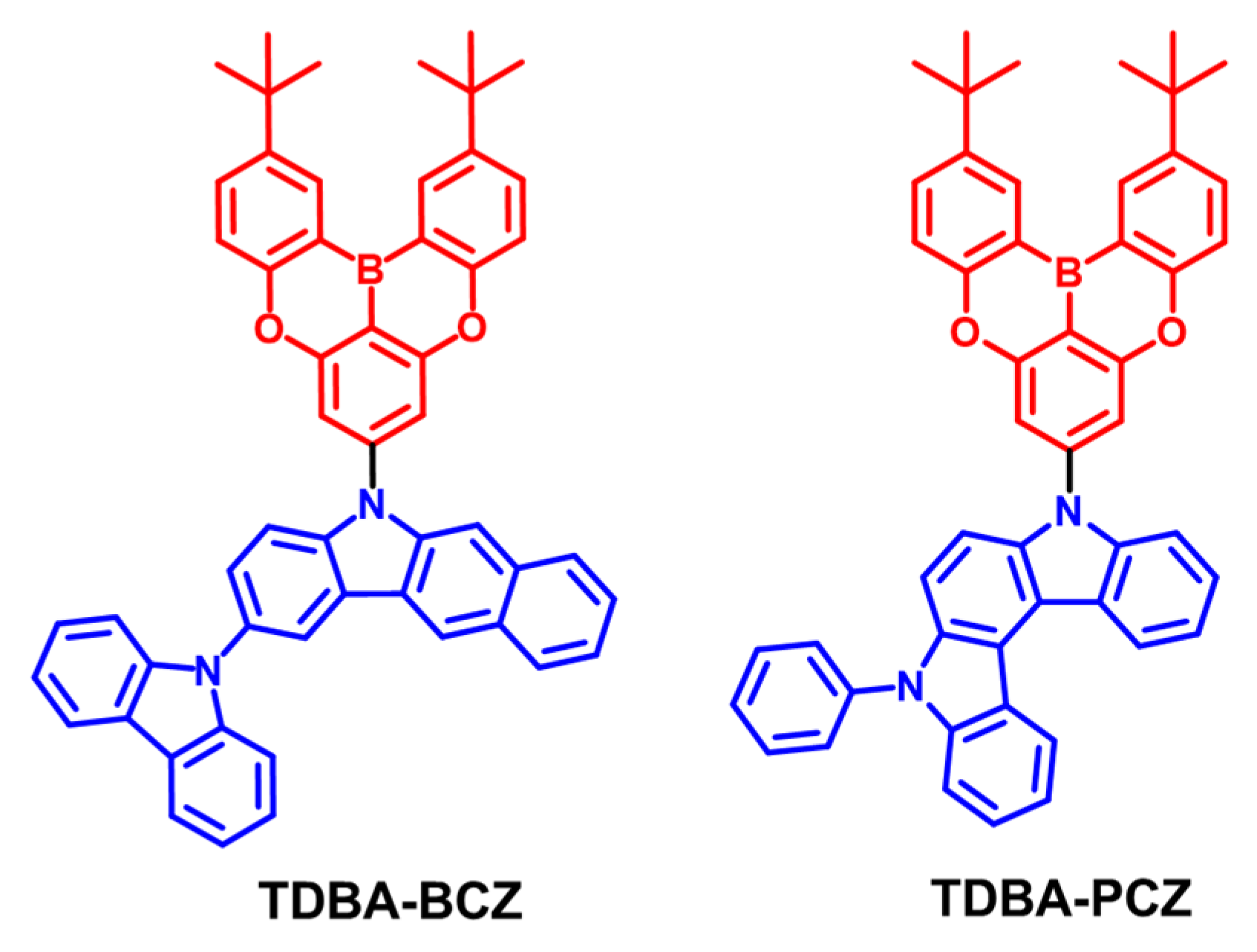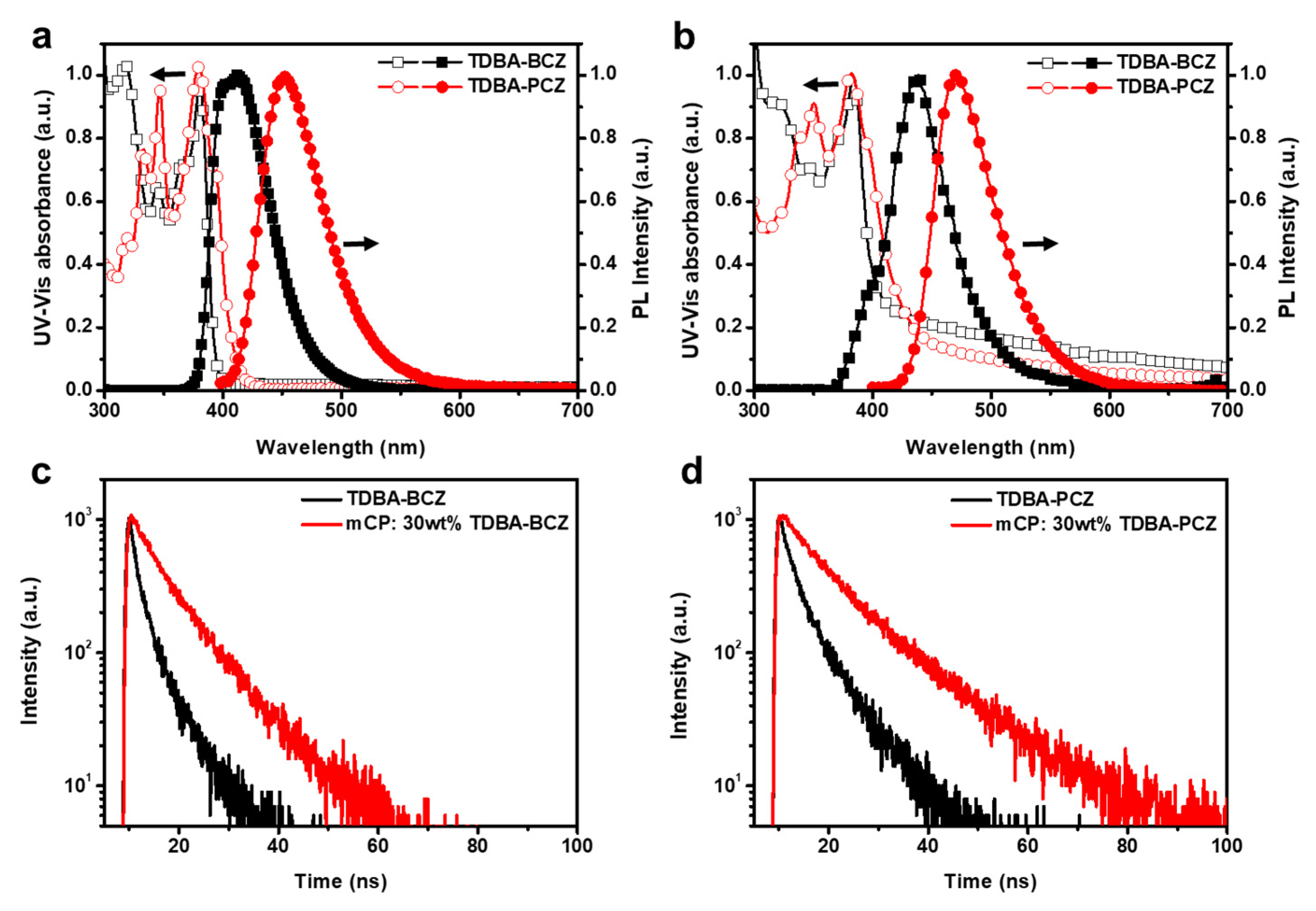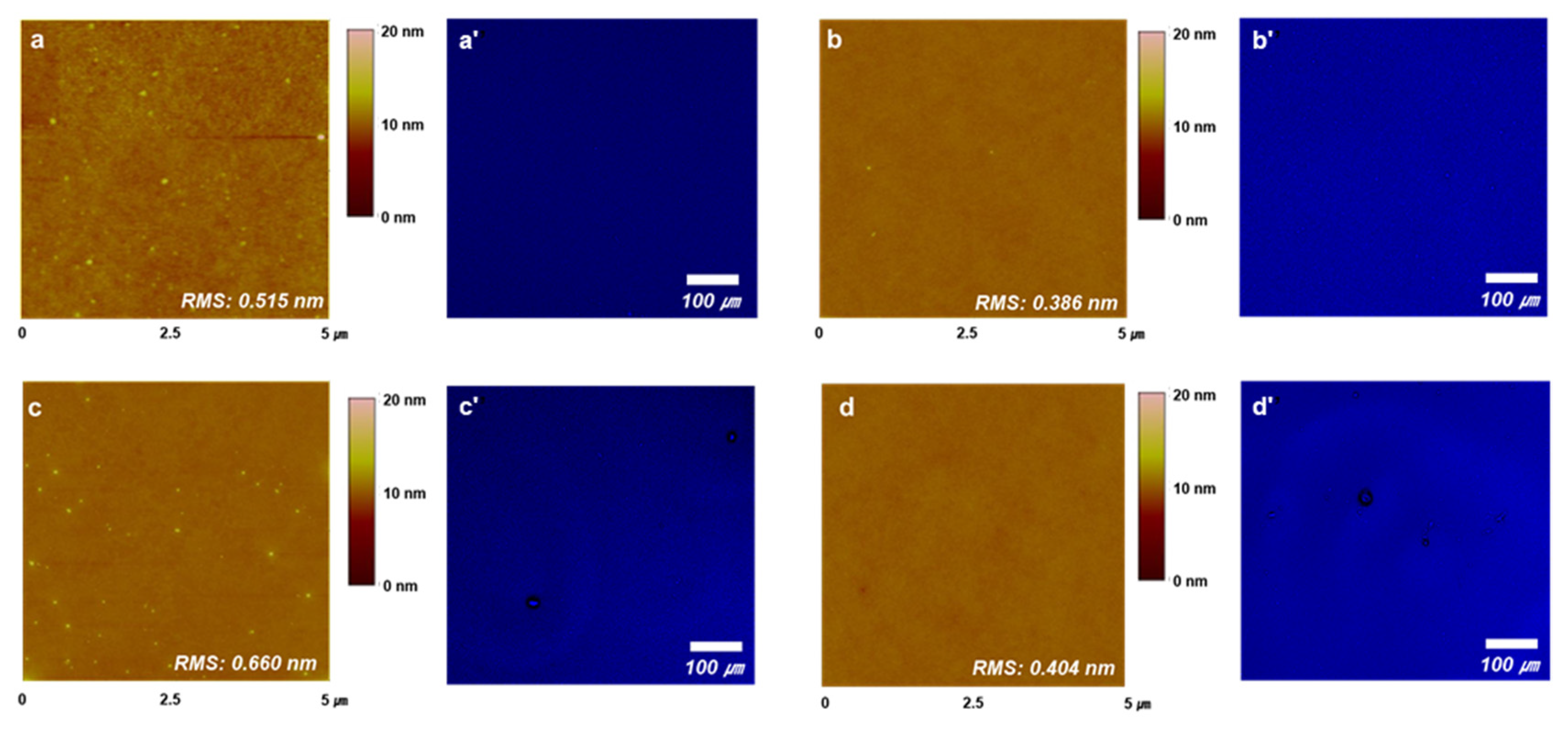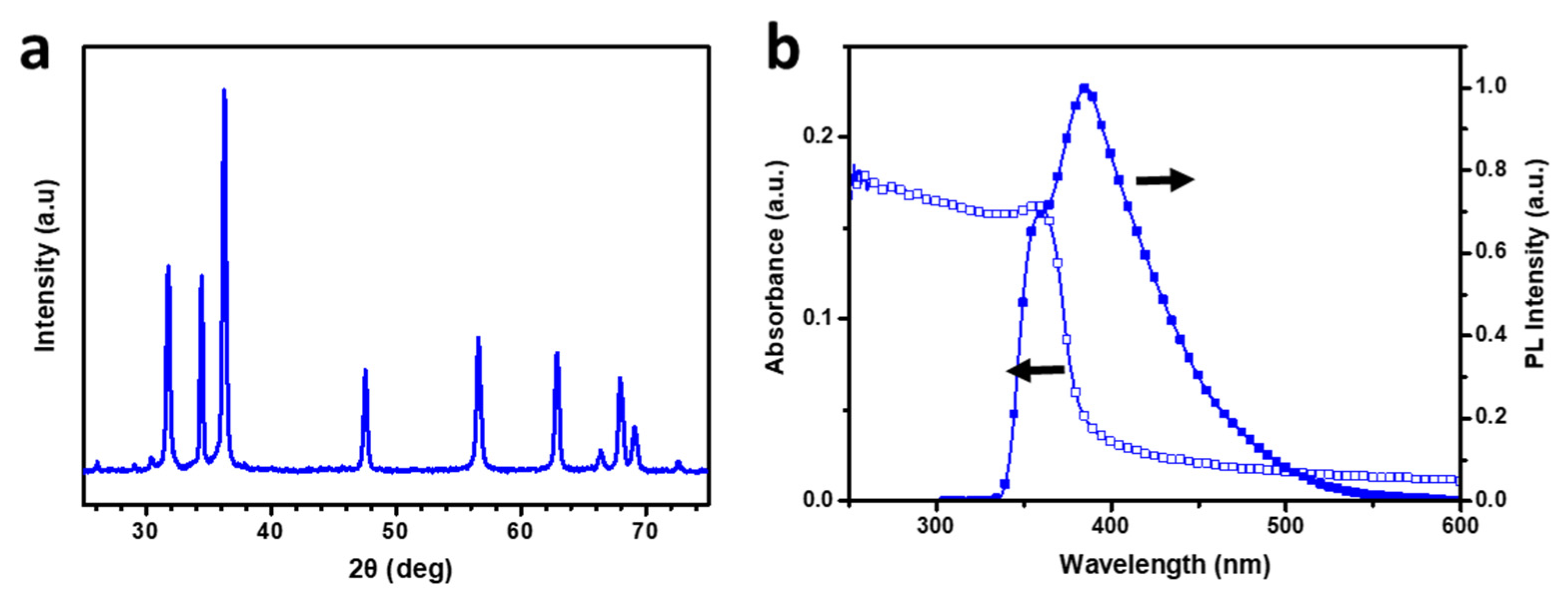Organic–Inorganic Hybrid Device with a Novel Deep-Blue Emitter of a Donor–Acceptor Type, with ZnO Nanoparticles for Solution-Processed OLEDs
Abstract
1. Introduction
2. Experimental
2.1. Synthesis of 2-(9H-Carbazol-9-yl)-5-(2,12-di-tert-butyl-5,9-dioxa-13b-boranaphtho [3,2,1-de]anthracen-7-yl)-5H-benzo[b]carbazole (TDBA-BCZ)
2.2. Synthesis of 4-Bromo-9-phenyl-9H-carbazole (5)
2.3. Synthesis of 9-Phenyl-4-(4,4,5,5-tetramethyl-1,3,2-dioxaborolan-2-yl)-9H-carbazole (6)
2.4. Synthesis of 4-(2-Nitrophenyl)-9-phenyl-9H-carbazole (7)
2.5. Synthesis of 5-Phenyl-5,8-dihydroindolo [2,3-c]carbazole (8)
2.6. Synthesis of 5-(2,12-Di-tert-butyl-5,9-dioxa-13b-boranaphtho [3,2,1-de]anthracen-7-yl)-8-phenyl-5,8-dihydroindolo [2,3-c]carbazole (TDBA-PCZ)
3. Results and Discussion
3.1. Molecular Design, Synthesis, and Characterization of Organic Blue Emitters
3.2. Photophysical Properties of Organic Blue Emitters
3.3. Surface Morphology and Thermal Properties of the Organic Blue Emitters
3.4. Characterization and Photophysical Properties of ZnO Nanoparticles
3.5. Electroluminescence Properties of Conventional and Inverted OLED Devices
4. Conclusions
Supplementary Materials
Author Contributions
Funding
Institutional Review Board Statement
Informed Consent Statement
Data Availability Statement
Conflicts of Interest
References
- Tang, C.W.; Vanslyke, S.A. Organic electroluminescent diodes. Appl. Phys. Lett. 1987, 51, 913–915. [Google Scholar] [CrossRef]
- Zhao, Z.; Deng, C.; Chen, S.; Lam, J.W.Y.; Qin, W.; Lu, P.; Wang, Z.; Kwok, H.S.; Ma, Y.; Qiu, H.; et al. Full emission color tuning in luminogens constructed from tetraphenylethene, benzo-2,1,3-thiadiazole and thiophene building blocks. Chem. Commun. 2011, 47, 8847–8849. [Google Scholar] [CrossRef] [PubMed]
- Gather, M.C.; Köhnen, A.; Falcou, A.; Becker, H.; Meerholz, K. Solution-processed full-color polymer organic light-emitting diode displays fabricated by direct photolithography. Adv. Funct. Mater. 2007, 17, 191–200. [Google Scholar] [CrossRef]
- Wu, M.F.; Yeh, S.J.; Chen, C.T.; Murayama, H.; Tsuboi, T.; Li, W.S.; Chao, I.; Liu, S.W.; Wang, J.K. the quest for high-performance host materials for electrophosphorescent blue dopants. Adv. Funct. Mater. 2007, 17, 1887–1895. [Google Scholar] [CrossRef]
- Wu, H.; Zhou, G.; Zou, J.; Ho, C.-L.; Wong, W.-Y.; Yang, W.; Peng, J.; Cao, Y. Efficient polymer white-light-emitting devices for solid-state lighting. Adv. Mater. 2009, 21, 4181–4184. [Google Scholar] [CrossRef]
- Sun, Y.; Giebink, N.C.; Kanno, H.; Ma, B.; Thompson, M.E.; Forrest, S.R. Management of singlet and triplet excitons for efficient white organic light-emitting devices. Nature 2006, 440, 908–912. [Google Scholar] [CrossRef]
- Kim, S.; Kim, B.; Lee, J.; Shin, H.; Park, Y.-I.; Park, J. Design of fluorescent blue light-emitting materials based on analyses of chemical structures and their effects. Mater. Sci. Eng. R Rep. 2016, 99, 1–22. [Google Scholar] [CrossRef]
- Kang, S.; Jung, H.; Lee, H.; Park, S.; Kim, J.; Park, J. Highly efficient dual-core derivatives with EQEs as high as 8.38% at high brightness for OLED blue emitters. J. Mater. Chem. C 2019, 7, 14709–14716. [Google Scholar] [CrossRef]
- Yook, K.S.; Jeon, S.O.; Kim, O.Y.; Lee, J.Y. Lifetime study of red phosphorescent organic light-emitting diodes with a double doping structure. J. Ind. Eng. Chem. 2010, 16, 813–815. [Google Scholar] [CrossRef]
- Lee, Y.G.; Lee, H.-N.; Kang, S.K.; Oh, T.S.; Lee, S.; Koh, K.H. Fabrication of highly efficient and stable doped red organic light-emitting device using 2-methyl-9,10-di(2-napthyl)anthracene and tris(8-hydroxyquinolinato)aluminum as cohost materials. Appl. Phys. Lett. 2006, 89, 183515. [Google Scholar] [CrossRef]
- Kwong, R.C.; Nugent, M.R.; Michalski, L.; Ngo, T.; Rajan, K.; Tung, Y.-J.; Weaver, M.S.; Zhou, T.X.; Hack, M.; Thompson, M.E.; et al. High operational stability of electrophosphorescent devices. Appl. Phys. Lett. 2002, 81, 162–164. [Google Scholar] [CrossRef]
- Kang, S.; Huh, J.-S.; Kim, J.-J.; Park, J. Highly efficient deep-blue fluorescence OLEDs with excellent charge balance based on phenanthro [9,10-d]oxazole-anthracene derivatives. J. Mater. Chem. C 2020, 8, 11168–11176. [Google Scholar] [CrossRef]
- Jung, H.; Kang, S.; Lee, H.; Yu, Y.J.; Jeong, J.H.; Song, J.; Jeon, Y.; Park, J. High efficiency and long lifetime of a fluorescent blue-light emitter made of a pyrene core and optimized side groups. ACS Appl. Mater. Interfaces 2018, 10, 30022–30028. [Google Scholar] [CrossRef] [PubMed]
- Kang, S.; Lee, H.; Jung, H.; Jo, M.; Jung, M.; Park, J. Highly efficient chrysene emitters based on optimized side groups for deep blue emission. Dye. Pigment. 2018, 156, 299–306. [Google Scholar] [CrossRef]
- Wang, Y.; Liu, W.; Ye, S.; Zhang, Q.; Duan, Y.; Guo, R.; Wang, L. Molecular engineering of anthracene-based emitters for highly efficient nondoped deep-blue fluorescent OLEDs. J. Mater. Chem. C 2020, 8, 9678–9687. [Google Scholar] [CrossRef]
- Pachariyangkun, A.; Senapak, W.; Sudyoadsuk, T.; Namuangruk, S.; Promarak, V. Efficient deep-blue fluorescent emitters from imidazole functionalized anthracenes for simple structure deep-blue electroluminescent devices. Org. Electron. 2020, 85, 105897. [Google Scholar] [CrossRef]
- Kim, R.; Lee, S.; Kim, K.H.; Lee, Y.J.; Kwon, S.K.; Kim, J.J.; Kim, Y.H. Extremely deep blue and highly efficient non-doped organic light emitting diodes using an asymmetric anthracene derivative with a xylene unit. Chem. Commun. 2013, 49, 4664–4666. [Google Scholar] [CrossRef]
- Yook, K.S.; Lee, J.Y. Organic materials for deep blue phosphorescent organic light-emitting diodes. Adv. Mater. 2012, 24, 3169–3190. [Google Scholar] [CrossRef]
- Tao, P.; Zhang, Y.; Wang, J.; Wei, L.; Li, H.; Li, X.; Zhao, Q.; Zhang, X.; Liu, S.; Wang, H.; et al. Highly efficient blue phosphorescent iridium(iii) complexes with various ancillary ligands for partially solution-processed organic light-emitting diodes. J. Mater. Chem. C 2017, 5, 9306–9314. [Google Scholar] [CrossRef]
- Lv, X.; Huang, R.; Sun, S.; Zhang, Q.; Xiang, S.; Ye, S.; Leng, P.; Dias, F.B.; Wang, L. Blue TADF Emitters based on indenocarbazole derivatives with high photoluminescence and electroluminescence efficiencies. ACS Appl. Mater. Interfaces 2019, 11, 10758–10767. [Google Scholar] [CrossRef]
- Wu, S.; Aonuma, M.; Zhang, Q.; Huang, S.; Nakagawa, T.; Kuwabara, K.; Adachi, C. High-efficiency deep-blue organic light-emitting diodes based on a thermally activated delayed fluorescence emitter. J. Mater. Chem. C 2014, 2, 421–424. [Google Scholar] [CrossRef]
- Jankus, V.; Data, P.; Graves, D.; McGuinness, C.; Santos, J.; Bryce, M.R.; Dias, F.B.; Monkman, A.P. Highly efficient TADF OLEDs: How the emitter-host interaction controls both the excited state species and electrical properties of the devices to achieve near 100% triplet harvesting and high efficiency. Adv. Funct. Mater. 2014, 24, 6178–6186. [Google Scholar] [CrossRef]
- Hirai, H.; Nakajima, K.; Nakatsuka, S.; Shiren, K.; Ni, J.; Nomura, S.; Ikuta, T.; Hatakeyama, T. One-step borylation of 1,3-diaryloxybenzenes towards efficient materials for organic light-emitting diodes. Angew. Chem. Int. Ed. Engl. 2015, 54, 13581–13585. [Google Scholar] [CrossRef] [PubMed]
- Ahn, D.H.; Kim, S.W.; Lee, H.; Ko, I.J.; Karthik, D.; Lee, J.Y.; Kwon, J.H. Highly efficient blue thermally activated delayed fluorescence emitters based on symmetrical and rigid oxygen-bridged boron acceptors. Nat. Photonics 2019, 13, 540–546. [Google Scholar] [CrossRef]
- Shin, H.; Jung, H.; Kim, B.; Lee, J.; Moon, J.; Kim, J.; Park, J. Highly efficient emitters of ultra-deep-blue light made from chrysene chromophores. J. Mater. Chem. C 2016, 4, 3833–3842. [Google Scholar] [CrossRef]
- Kim, B.; Park, Y.; Lee, J.; Yokoyama, D.; Lee, J.-H.; Kido, J.; Park, J. Synthesis and electroluminescence properties of highly efficient blue fluorescence emitters using dual core chromophores. J. Mater. Chem. C 2013, 1, 432–440. [Google Scholar] [CrossRef]
- Lee, J.; Park, J. Synthesis and electroluminescence of novel pyrene-fused chromophores. Org. Lett. 2015, 17, 3960–3963. [Google Scholar] [CrossRef]
- Kang, S.; Lee, H.; Shim, Y.; Park, S.; Park, J. Fine tuning of bipolar side group on dual anthracene core derivatives for highly efficient blue emitters. Dye. Pigment. 2020, 181, 108555. [Google Scholar] [CrossRef]
- Kim, S.-K.; Yang, B.; Park, Y.-I.; Ma, Y.; Lee, J.-Y.; Kim, H.-J.; Park, J. Synthesis and electroluminescent properties of highly efficient anthracene derivatives with bulky side groups. Org. Electron. 2009, 10, 822–833. [Google Scholar] [CrossRef]
- Huang, M.; Yu, R.; Xu, K.; Ye, S.; Kuang, S.; Zhu, X.; Wan, Y. An arch-bridge-type fluorophore for bridging the gap between aggregation-caused quenching (ACQ) and aggregation-induced emission (AIE). Chem. Sci. 2016, 7, 4485–4491. [Google Scholar] [CrossRef]
- Hu, W.; Miao, X.; Tao, H.; Baev, A.; Ren, C.; Fan, Q.; He, T.; Huang, W.; Prasad, P.N. Manipulating nonradiative decay channel by intermolecular charge transfer for exceptionally improved photothermal conversion. ACS Nano 2019, 13, 12006–12014. [Google Scholar] [CrossRef]
- Ma, L.; Yu, Y.; Li, L.; Lei, T.; Jiao, B.; Hou, X.; Wu, Z. Efficient amplified spontaneous emission based on π-conjugated fluorophore-cored molecules studied by density functional theory. Org. Electron. 2018, 57, 123–132. [Google Scholar] [CrossRef]
- Park, Y.; Kim, B.; Lee, C.; Hyun, A.; Jang, S.; Lee, J.-H.; Gal, Y.-S.; Kim, T.H.; Kim, K.-S.; Park, J. Highly efficient new hole injection materials for OLEDs based on dimeric phenothiazine and phenoxazine derivatives. J. Phys. Chem. C 2011, 115, 4843–4850. [Google Scholar] [CrossRef]
- Kang, S.; Kwon, H.; Pu, Y.J.; Park, J. High-efficiency deep-blue emitter consisting of a chrysene core and optimized side groups. Mater. Today Energy 2021, 21, 100706. [Google Scholar] [CrossRef]
- Shih, P.I.; Chuang, C.Y.; Chien, C.H.; Diau, E.W.G.; Shu, C.F. Highly efficient non-doped blue-light-emitting diodes based on an anthrancene derivative end-capped with tetraphenylethylene groups. Adv. Funct. Mater. 2007, 17, 3141–3146. [Google Scholar] [CrossRef]
- Zhou, T.; Zhang, K.; Cao, Q.; Xu, H.; Ban, X.; Zhu, P.; Li, Q.; Shi, L.; Ge, F.; Jiang, W. Benzonitrile-based AIE polymer host with a simple synthesis process for high-efficiency solution-processable green and blue TADF organic light emitting diodes. J. Mater. Chem. C 2022, 10, 2109–2120. [Google Scholar] [CrossRef]
- Zeng, S.; Xiao, C.; Zhou, J.; Dong, Q.; Li, Q.; Lim, J.; Ma, H.; Lee, J.Y.; Zhu, W.; Wang, Y. Deep blue emitter based on tris(triazolo)triazine moiety with CIE y < 0.08 for highly efficient solution-processed organic light-emitting diodes via molecular strategy of “hot excitons”. Adv. Funct. Mater. 2022, 32, 2113183. [Google Scholar] [CrossRef]
- Zhou, T.; Ling, Z.; Tang, Z.; Wang, S.; Guo, K.; Chen, G.; Cheng, Z.; Dai, X.; Gao, H.; Xu, T.; et al. Efficient solution-processed inverted organic light-emitting diodes by using polyethyleneimine as interface layer. Phys. Status Solidi (a) 2018, 215, 1800138. [Google Scholar] [CrossRef]
- Park, S.; Suh, M.; Kim, K.; Kim, M.; Cho, H.; Shin, H.; Seo, H.G.; Jung, W.; Jeon, D.Y. Effect of spatial molecular configuration of ZnO/polyethylenimine hybrid electron injection materials on OLEDs performance. Org. Electron. 2019, 75, 105427. [Google Scholar] [CrossRef]
- Kang, S.; Jillella, R.; Jeong, J.; Park, Y.I.; Pu, Y.J.; Park, J. Improved electroluminescence performance of perovskite light-emitting diodes by a new hole transporting polymer based on the benzocarbazole moiety. ACS Appl. Mater. Interfaces 2020, 12, 51756–51765. [Google Scholar] [CrossRef]
- Jung, H.; Shin, H.; Kim, S.; Kim, J.; An, B.-K.; Lee, J.-H.; Ihee, H.; Park, J. High electroluminescence efficiency and long device lifetime of a fluorescent green-light emitter using aggregation-induced emission. J. Ind. Eng. Chem. 2020, 87, 213–221. [Google Scholar] [CrossRef]
- Guo, X.; Yuan, P.; Fan, J.; Qiao, X.; Yang, D.; Dai, Y.; Sun, Q.; Qin, A.; Tang, B.Z.; Ma, D. Unraveling the Important role of high-lying triplet-lowest excited singlet transitions in achieving highly efficient deep-blue AIE-based OLEDs. Adv. Mater. 2021, 33, e2006953. [Google Scholar] [CrossRef] [PubMed]
- Lin, C.; Han, P.; Qu, F.; Xiao, S.; Li, Y.; Xie, D.; Qiao, X.; Yang, D.; Dai, Y.; Sun, Q.; et al. Suppressing singlet-triplet annihilation processes to achieve highly efficient deep-blue AIE-based OLEDs. Mater. Horiz. 2022, 9, 2376–2383. [Google Scholar] [CrossRef] [PubMed]
- Liu, D.; Wei, J.Y.; Tian, W.W.; Jiang, W.; Sun, Y.M.; Zhao, Z.; Tang, B.Z. Endowing TADF luminophors with AIE properties through adjusting flexible dendrons for highly efficient solution-processed nondoped OLEDs. Chem. Sci. 2020, 11, 7194–7203. [Google Scholar] [CrossRef] [PubMed]
- Wilken, S.; Scheunemann, D.; Wilkens, V.; Parisi, J.; Borchert, H. Improvement of ITO-free inverted polymer-based solar cells by using colloidal zinc oxide nanocrystals as electron-selective buffer layer. Org. Electron. 2012, 13, 2386–2394. [Google Scholar] [CrossRef]
- Pu, Y.J.; Morishita, N.; Chiba, T.; Ohisa, S.; Igarashi, M.; Masuhara, A.; Kido, J. Efficient electron injection by size- and shape-controlled zinc oxide nanoparticles in organic light-emitting devices. ACS Appl. Mater. Interfaces 2015, 7, 25373–25377. [Google Scholar] [CrossRef]
- Srikant, V.; Clarke, D.R. On the optical band gap of zinc oxide. J. Appl. Phys. 1998, 83, 5447–5451. [Google Scholar] [CrossRef]
- van Dijken, A.; Meulenkamp, E.A.; Vanmaekelbergh, D.; Meijerink, A. The luminescence of nanocrystalline ZnO particles: The mechanism of the ultraviolet and visible emission. J. Lumin. 2000, 87, 454–456. [Google Scholar] [CrossRef]
- Kreiza, G.; Berenis, D.; Banevičius, D.; Juršėnas, S.; Javorskis, T.; Orentas, E.; Kazlauskas, K. High efficiency and extremely low roll-off solution- and vacuum-processed OLEDs based on isophthalonitrile blue TADF emitter. Chem. Eng. J. 2021, 412, 128574. [Google Scholar] [CrossRef]
- He, Y.; Qiao, Z.; Cai, X.; Li, M.; Li, W.; Xie, W.; Qiu, W.; Wang, L.; Su, S.J. Pyridine-based bipolar hosts for solution-processed bluish-green thermally activated delayed fluorescence devices: A subtle regulation of chemical stability and carrier transportation. ACS Appl. Mater. Interfaces 2020, 12, 49905–49914. [Google Scholar] [CrossRef]
- Chen, S.; Chu, T.; Chen, C.; Chen, J.; Chen, C.H. High-efficiency inverted transparent blue organic light- emitting devices. J. Inf. Disp. 2006, 2006, 984–986. [Google Scholar]
- Liu, J.; Li, Y.; Wang, S.; Ling, Z.; Lian, H.; Xu, T.; Zhang, X.; Liao, Y.; Wei, B. Long-lasting and efficient inverted pure blue organic light-emitting diodes by inserting an ultrathin aluminum interlayer. J. Alloy. Compd. 2020, 814, 152299. [Google Scholar] [CrossRef]
- Wang, R.; Liu, Y.; Hu, T.; Wei, X.; Liu, J.; Li, Z.; Hu, X.; Yi, Y.; Wang, P.; Wang, Y. Solution-processed white organic light-emitting diodes with bi-component emitting layer based on symmetry blue spiro-sulfone derivative. Org. Electron. 2019, 71, 24–30. [Google Scholar] [CrossRef]






| Solution a | Film b | PLQY c (%) | ES/ET d (eV) | ΔEST e (eV) | τF f (ns) | HOMO g (eV) | LUMO (eV) | Eg (eV) | |||
|---|---|---|---|---|---|---|---|---|---|---|---|
| UVmax (nm) | PLmax (FWHM) (nm) | UVmax (nm) | PLmax (FWHM) (nm) | ||||||||
| TDBA-BCZ | 317, 345, 380 | 413 (55) | 318, 346, 383 | 436 (58) | 34/36/37 | 3.28/ 2.96 | 0.32 | 3.13/7.99 | −5.55 | −2.47 | 3.08 |
| TDBA-PCZ | 333, 346, 379 | 451 (60) | 338, 350, 382 | 470 (61) | 48/58/52 | 3.02/ 2.89 | 0.13 | 5.07/12.2 | −5.26 | −2.27 | 2.99 |
| EML | Vona (V) | CE (cd/A) b | EQE (%) c | CIE (x, y) d | ELmax (nm) | FWHM (nm) | ||||
|---|---|---|---|---|---|---|---|---|---|---|
| Max | at 1000 cd/m2 | at 2000 cd/m2 | Max | at 1000 cd/m2 | at 2000 cd/m2 | |||||
| mCP: 30 wt% TDBA-BCZ e | 4.89 | 8.67 | 8.26 | 6.85 | 7.73 | 7.34 | 6.16 | (0.161, 0.046) | 428 | 47 |
| mCP: 30 wt% TDBA-PCZ e | 4.29 | 14.24 | 13.72 | 13.20 | 10.58 | 10.14 | 9.71 | (0.151, 0.155) | 461 | 58 |
| mCP: 30 wt% TDBA-PCZ f | 8.01 | 1.09 | 1.04 | - | 0.32 | 0.30 | - | (0.156, 0.232) | 469 | 74 |
Publisher’s Note: MDPI stays neutral with regard to jurisdictional claims in published maps and institutional affiliations. |
© 2022 by the authors. Licensee MDPI, Basel, Switzerland. This article is an open access article distributed under the terms and conditions of the Creative Commons Attribution (CC BY) license (https://creativecommons.org/licenses/by/4.0/).
Share and Cite
Kang, S.; Jillella, R.; Park, S.; Park, S.; Kim, J.H.; Oh, D.; Kim, J.; Park, J. Organic–Inorganic Hybrid Device with a Novel Deep-Blue Emitter of a Donor–Acceptor Type, with ZnO Nanoparticles for Solution-Processed OLEDs. Nanomaterials 2022, 12, 3806. https://doi.org/10.3390/nano12213806
Kang S, Jillella R, Park S, Park S, Kim JH, Oh D, Kim J, Park J. Organic–Inorganic Hybrid Device with a Novel Deep-Blue Emitter of a Donor–Acceptor Type, with ZnO Nanoparticles for Solution-Processed OLEDs. Nanomaterials. 2022; 12(21):3806. https://doi.org/10.3390/nano12213806
Chicago/Turabian StyleKang, Seokwoo, Raveendra Jillella, Sunwoo Park, Sangshin Park, Joo Hwan Kim, Dakyeung Oh, Joonghan Kim, and Jongwook Park. 2022. "Organic–Inorganic Hybrid Device with a Novel Deep-Blue Emitter of a Donor–Acceptor Type, with ZnO Nanoparticles for Solution-Processed OLEDs" Nanomaterials 12, no. 21: 3806. https://doi.org/10.3390/nano12213806
APA StyleKang, S., Jillella, R., Park, S., Park, S., Kim, J. H., Oh, D., Kim, J., & Park, J. (2022). Organic–Inorganic Hybrid Device with a Novel Deep-Blue Emitter of a Donor–Acceptor Type, with ZnO Nanoparticles for Solution-Processed OLEDs. Nanomaterials, 12(21), 3806. https://doi.org/10.3390/nano12213806






